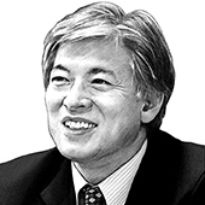[Column] A brave new world of metaphor

The author is an emeritus professor and former president of Korea University.
The Year of the Tiger is giving way to the Year of the Rabbit fast. Many seismic shifts shook the world after the wave of globalization was critically challenged everywhere in 2022. The heated U.S.-China contest led to the collapse of global value chains to be replaced by new ones. Based on its technological leverage, America has kept a close watch on China and started rallying support from the North Atlantic Treaty Organization (NATO) and the fledgling Quadrilateral Security Dialogue (Quad). In reaction, China and Russia are keeping checks on the West by reinforcing their military cooperation.
The Ukraine war triggered by Russian President Vladimir Putin in February to “protect Russians in the neighbor” continues. The Russian military spray-painted the letter “Z” — a pro-war symbol — on its tanks and armored vehicles to help justify Putin’s invasion of Ukraine. (Some military experts interpret “Z” as “Za pobedy,” the Russian for “for victory,” or as “Zapad,” the Russian for the “West.”) The move constitutes an adroit use of metaphor to vindicate an act of aggression.

Today’s world is dominated by metaphor — as dexterously reflected in concise messages on Instagram or Tick Tock — to thrust the world into an emotional realm based on quick judgment instead of deep introspection. In that world of metaphor, fake news weighs over facts. As a result, the world is swiftly morphing into an anti-intellectual community where someone appeals to the public to draw their immediate reaction without telling the facts — and vanishes after leaving only the images of symbolism behind.
In her 1978 book “Illness as Metaphor,” American philosopher Susan Sontag, an iconic intellect in the U.S., preached that humans are more affected by the symbolism and metaphor of illness than the essence of the illness. For instance, tuberculosis, which swept the world in the 19th century, carried a metaphor for compassion, as the illness mostly appeared in thin and sensitive people. She quoted a literary critic who expressed concerns about the decline of literature and art after mankind overcame tuberculosis by the end of the 21st century.
Meanwhile, cancers carry the metaphor for struggle due to its fatality rather than the metaphor for clemency as with tuberculosis. Koreans often use the phrase “cancerous beings” to refer to vicious individuals or social vices that need to be eliminated from society. The metaphor for AIDS which appeared in the late 20th century also was a “curse for sexual immorality” rather than a virus-triggered disease. When you rely on metaphor to comprehend illness, you fall into the trap of anxiety, fear and resentment.
Metaphor critically blunts a human ability for rational judgement to the extent of provoking a collective madness as seen in the frantic witch hunts in the Medieval inquisition trials. In the infamous military trial of Alfred Dreyfus, the French artillery officer was falsely convicted of spy charges and sentenced to life imprisonment just because he was of Jewish descent. In an open letter entitled “J’accuse,” or “I accuse” in English, Emile Zola vehemently denounced the French government for bias. Since then, the French society suffered an extreme conflict between pro-Dreyfus group and anti-Dreyfus group. The Dreyfus affair became a symbol of social division in France.
Title 42 signed by U.S. president Donald Trump aims to allow U.S. border officials to quickly expel migrants and asylum-seekers to prevent the spread of Covid-19. The ban was extended to illegal immigrants from Central and South America beyond hate crimes against Asians after the virus apparently originated from China. Such ill-designed political metaphor encouraged low-income whites to attack the government for their unemployment and restructuring.
The specter of metaphor is roaming in Korea. All the methodically-orchestrated metaphors during the military dictatorship — for anti-Communist campaigns, anti-North Korean spy operations, anti-government movement and the October Restoration, for instance — were replaced by novel metaphors for the Mad Cow Disease, the Sewol ferry tragedy, the nuclear phase-out under the previous administration, the campaign to root out pro-Japanese forces in Korea, the candlelight vigils, the national flag and the Itaewon disaster. Here again, metaphor dominates substance.
Our politicians are busy luring voters to their favor by metaphor. They create a new breed of metaphor and reinforce it by avoiding substance. In return, Koreans are increasingly trapped into the metaphoric structure after reserving their objective judgment on reality. Even the press and lawyers are infected with the virus from politics and reproduce the metaphor. If independent intellectuals criticize politicians with different ideology, they are attacked for siding with both sides.
The flag of metaphor is fluttering everywhere. It looks as if the specter of Hitler were revisiting the world after wreaking havoc on the entire Europe with his malicious metaphor for Nazism and antisemitism. Metaphor must be used for the beauty of poetic language. Intellectuals are required to take the lead in stopping metaphor from being exploited for political catchphrases or public incitement.
Translation by the Korea JoongAng Daily staff.










with the Korea JoongAng Daily
To write comments, please log in to one of the accounts.
Standards Board Policy (0/250자)